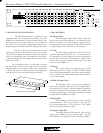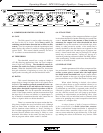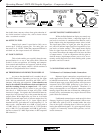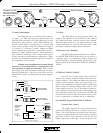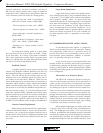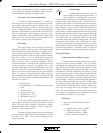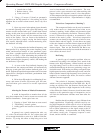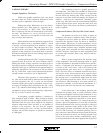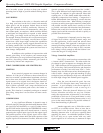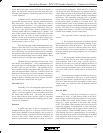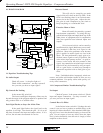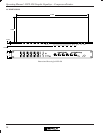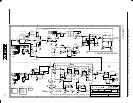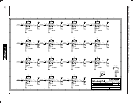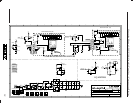
12
Operating Manual - DPX-100 Graphic Equalizer - Compressor/Limiter
dynamic spectrum will be pushed toward the “middle”.
This is quite different from simple limiting, where only
loud peaks are subjected to gain reduction. More than
anything else, it is this double-ended effect which dis-
tinguishes compression from limiting. Compression is
further differentiated from limiting by careful selection
of attack and release times. When limiting is employed
to protect an audio system against transient volume peaks
and possible overload, attack time is usually set as fast
as possible, consistent with distortion-free performance.
Release time would also be relatively short, so that the
output signal would be restored to normal as quickly as
possible after the transient.
Compression is frequently used to keep over-
all signal level within a specific dynamic range, and
for this application, slower attack and release times
are usually chosen. This approach is analogous to our
manual gain riding example, where our operator is fad-
ing the music up and down to keep it fairly constant,
but is doing it slowly enough so that the listener is un-
aware that the gain is being altered.
Voltage Controlled Amplifiers
Early VCA’s were based on vacuum tubes with
a “remote cutoff” characteristic. The tube would sim-
ply change its gain in response to a changing bias volt-
age. Tubes developed for this purpose did an excellent
job, in fact they could exceed the noise and distortion
performance of today’s best solid state VCA’s. Unfor-
tunately, they also had some serious disadvantages pe-
culiar to tubes - change of gain and matching as aging
took place, heat, microphonics, high cost, and the need
for both high-voltage and filament power supplies.
Over the years the need for good, low-cost,
solid state VCA brought about many innovative ap-
proaches. A good example is the electro-optical at-
tenuator where a photocell is used as one leg of a
potentiometer. Since the photocell behaves as a true
resistor, distortion and noise are very low. Unfortu-
nately, the response time of photocells is slow and un-
predictable so their use in a fast peak-limiter is really
not feasible. Also, the matching between units is very
poor so that stereo tracking is not possible without te-
dious hand-matching of photocells.
Another approach uses a field-effect transis-
tor (FET) as a variable resistor. Here, at least, the re-
sponse time is fast (in the nanosecond range), but
matching between units is still poor, requiring hand
matching for stereo. An additional problem is that a
FET will only act as a pure resistor with very small
signals applied so it is necessary to attenuate an input
out of an audio system, you have to keep your standard
operating level as high as possible without risking distor-
tion.
GAIN RIDING
One solution to the noise vs. distortion trade-off
is to keep your hand on the level control and manually
adjust gain to suit the program. Indeed, there are times
when this approach is entirely satisfactory. However, in
most types of music there are instantaneous, short dura-
tion volume peaks, or transients, which would be difficult
to anticipate and impossible to respond to with manual
gain riding, you simply could not bring the level down
fast enough. In many situations, this can present real prob-
lems. For example, in recording, an extra burst of enthu-
siasm from a lead singer might overload the capabilities
of your recording tape, causing ragged distortion and ne-
cessitating another take. In sound reinforcement, a sud-
den burst of energy through the system can blow fuses or
even damage loudspeakers.
In addition to the problem of response time with
manual gain riding, it also requires your constant atten-
tion, which takes you away from more important jobs. The
need for a fast-acting, reliable, automatic gain control is
answered by limiters and compressors.
WHAT COMPRESSORS AND LIMITERS DO
LIMITING
In any musical program are constant changes in
loudness. It is the job of a limiter to detect when the vol-
ume has exceeded a predetermined maximum safe level,
and to then turn down the volume. When the incoming
signal returns to its original level, the limiter should re-
spond by restoring the gain to normal. Thus, when the
level is within a specified “safe” range, the limiter has no
effect. When an occasional peak occurs, the limiter re-
sponds. This situation is completely analogous to manual
gain riding, except that it occurs faster and more consis-
tently.
COMPRESSION
A very significant difference in dynamic range is
achieved simply by changing the relationship between nomi-
nal signal level and threshold, as a result of either increas-
ing the GAIN and/or decreasing the THRESHOLD control.
The most interesting effect to be noted, however, is seen by
comparing the original input signal with the output signal.
The quietest portions of the original signal will be effec-
tively increased in volume while the loudest portions of the
original signal will be decreased. In effect, both ends of the



